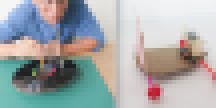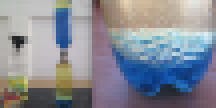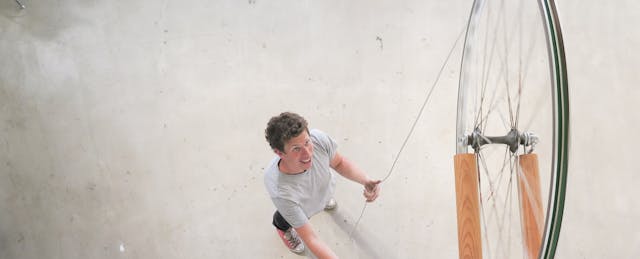Fun is science educator Sam Haynor’s superpower.
There are schools out there—you know who you are—with reputations as places “where fun goes to die.” Haynor not only brings fun back to life, he makes it stronger, louder, and more joyful than ever.
Consider just a few of Haynor’s current gigs:
- He signed a deal this summer to write a book called Marvelous Makeable Monsters.
- He advises Playground Ideas, a global nonprofit that helps communities build stimulating play spaces with local materials and people.
- He is creating the Oakland Toy Lab, a “community-based wonder lab for students to build, tinker, explore, make, break, and learn.”
At the moment, the Toy Lab is a collection of 100 “science experiences”—projects, demonstrations, experiments, and explorations—for teachers, parents, and students who need an inoculation against the tedium and opacity that often poison science instruction. They’re hosted on the free DIY-driven Instructables website.
Say you wanted to teach Newtonian laws of motion. What do you do? No problem, Haynor says. Try Toy Lab’s Self-Defeating Fan Car (seven steps, 30 minutes, $2 for materials).
A lesson on sound and resonance? That’s easy: The Tooth Phonograph (five steps, 15 minutes, 50 cents).
What about anatomy and mechanical motion? Look no further than Chicken Foot Dissection (seven steps, 50 minutes, 30 cents).

A little bit of everything
In many ways, the Toy Lab’s projects are a sprawling summary of Haynor’s own time in the classroom as a student, teacher, and consultant. They reflect the days growing up in Seattle, the stint teaching high school biology in the Boston public schools, the work at refugee camps and elsewhere in Pakistan, Afghanistan, Peru, Haiti, Ecuador, and Palestine, and the role teaching both students and teachers at San Francisco’s Mission Science Workshop. They also draw on the evanescent 100 Days of Spring, when Haynor and a friend rented a storefront in downtown San Francisco and transformed the space into what the San Francisco Bay Guardian described as “a gypsy-tent-circus-wagon-theater-gallery-cum-classroom.” Haynor and his colleague hosted 100 events, taught 100 classes, and made 100 videos in 100 days. (Yes, Haynor admits to an inexplicable fascination with 100.)
Haynor’s Instructables seem to include a little bit of everything, from the Bike Wheel Gyroscope to the Self-Watering Terrarium, from the Craft Stick Catapult to the PVC Saxophone (“30–40 minutes to make, a lifetime to master”). But in Haynor’s mind, his projects fall roughly into four categories:
- Science Museum Exhibits for Under $5: Haynor credits San Francisco’s Exploratorium as the chief inspiration. “These projects take beautiful ideas and make them affordable,” he says, citing the Bicycle Wheel Wave Machine as an ideal example.
- Classroom Demonstrations: “I wanted teachers to be able to make science presentations without expensive materials,” he says, pointing to the many plant and animal dissections as examples.
- Little Learning Environments: “These are open-ended, student-choice projects that let students learn organically,” Haynor says. Circuit Tiles and Bottle Trees are but two examples.
- Toys from Trash: Both the name and the inspiration for these come from the work of an “incredible man" named Arvind Gupta in Pune, India. Bag Monsters and The Most Annoying Sound in the World are two favorites.

Make it fun
One of Haynor’s favorite projects—combining learning, affordability and “super fun”—is the Strobe Goggles. “It’s a fun way of mixing the notions of goofiness and fashion with principles of light and persistence of vision, which is what makes it all work,” he explains. “This project started at the Mission Science Workshop, and what we were exploring is how you view things that oscillate or repeat. We were looking at guitar strings and the way they wobble. You can do some amazing things when you put a strobe light on guitar strings and you can see these amazing wave patterns emerge that would be impossible to see otherwise.”
So Haynor went looking for a way to create a fun, stylish, and inexpensive tool that might give every student access to the strobe effect. He took cheap sunglasses, punched out the lenses, and attached a battery pack, potentiometer (an on-off knob), and 3-volt DC motor with hot glue and solder. He cut out a six-inch cardboard circle, sliced a wedge out of it, and attached the circle to the motor.
According to Haynor, the project takes seven steps, 45 minutes, and about $4.50 in materials, and it opens up a world of visual possibilities. “Strobe goggles,” he writes in what he calls his Jabberwocky prose, “can reverse water drops, make your auntie look fly at dancing, and even give you mild seizures / migraines if you’re lucky!”

Encourage deep learning
Behind all the unbridled exuberance, Haynor has some serious thoughts about play. He studied educational psychology (and played Ultimate Frisbee) at Dartmouth and international education at the Harvard Graduate School of Education. And he understands that providing a step-by-step guide to all these projects and demonstrations is a mixed blessing.
“Stanford education professor Paulo Blikstein said that just because you have students with hands-on learning doesn’t mean deep thinking is going on,” says Haynor. “Take something like a Sponge Motorboat,” he adds. It’s an electronics project, and it also explores propulsion and buoyancy. But, explains Haynor, “if you’re telling the kids exactly the way to do it, they’re not actually learning that much.”
Insteads, he says, “we have to think of ways that will encourage deep learning.” Teachers can do this by tying hands-on projects to equations, research, and real-life. “You might take a formula for motion and try to calculate, ‘how fast do I expect my motorboat to go knowing how heavy it is and how much water the paddle is displacing?’” says Haynor. “Then you put it to the test to see if it’s going that fast. Why or why not? How do I need to adjust my model based on what I’m learning?”
Shrink the cost
The Sponge Motorboat, according to Haynor’s accounting, costs about $1.25 to make. He delights in finding ways to shrink the cost of his projects—Strobe Goggles for $4.50 rather than a strobe light running anywhere from twenty bucks to several hundred dollars. “Every teacher,” he says, “knows what it’s like to cut into their own paycheck, no matter what subject they’re teaching. So if I can make something that costs 25 cents less a project, that is $5 less for a class of 20.” Over the course of a school year, Haynor reckons, these projects could save a teacher a big chunk of change.

Improvise and explore
Change, in its many forms, is also something that delights Haynor, who likes malleable projects that allow students to explore uncharted directions. The Circuit Tiles Instructable, for example, creates endless possibilities for students to experiment with lights, motors, and other electronics. Haynor’s itch to improvise is why he applauds any suggested changes and additions to his projects; the Comments sections of his Instructables are must-reads.
Haynor embraces these different directions partly because he has learned that his projects often end up being about something other than his original intentions. They can be about community building, confidence boosting, or boundary bashing.
Or simple slack-jawed awe. “I made a Liquid Hourglass out of a couple of bottles in a refugee camp in Pakistan,” Haynor recalls. “The project’s about the exchange of water and oil, one-drop blips at a time. You’re getting these beautiful bubbles and there’s a lot of density science going on. But it’s also visually captivating. It’s a lava lamp—psychedelic.
“I built one and then came back, delighted to see a crowd of kids around it all staring. I came in and started to talk about the science of it, and they all went, ‘Shhhhhh. Can we just enjoy this?’”

Find your muse
Sam Haynor’s ideas come from everywhere. In addition to the Exploratorium, Mission Science Workshop, and Arvind Gupta’s Toys from Trash, his go-to muses include:
- DIY.org—“A huge online inspiration for the vast creativity of youth.
- Tinkering: Kids Learn by Making Stuff—“A fantastic book by Curt Gabrielson on how kids can do deep thinking while they get their hands dirty making things.”
- RAFT: Resource Area for Teaching—“Wonderful resource for low-cost project ideas.”
- Make Magazine—“A great magazine for documenting and chronicling today's world of Making.”



